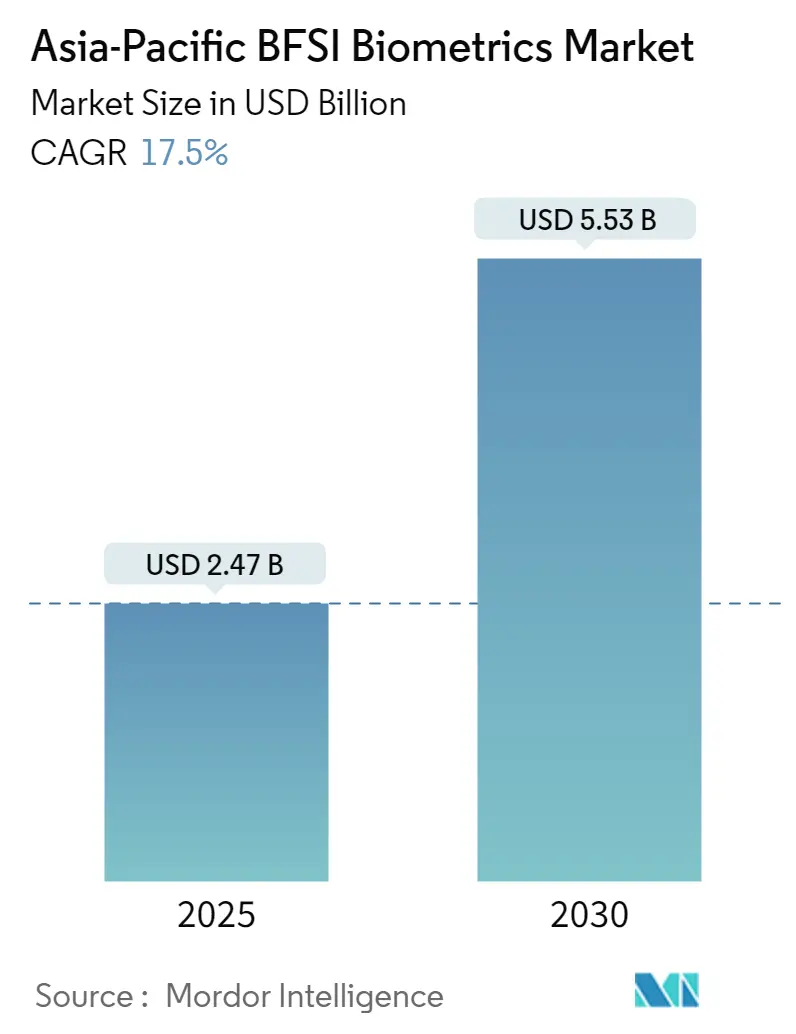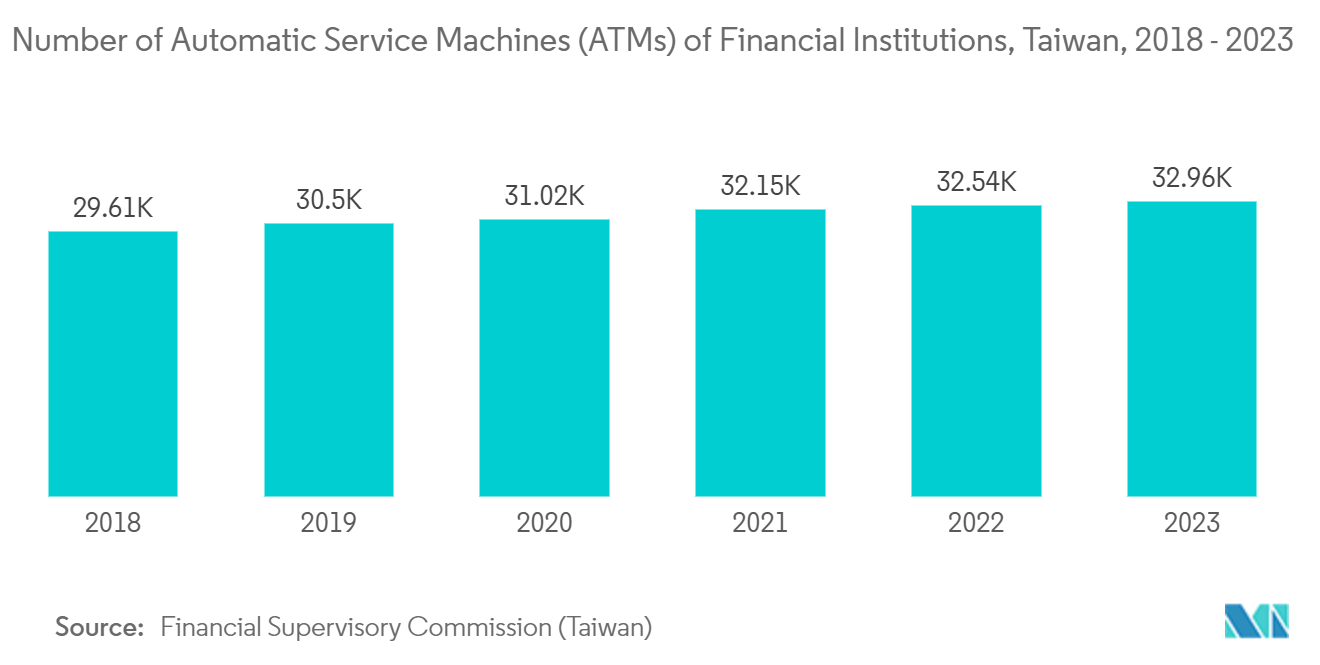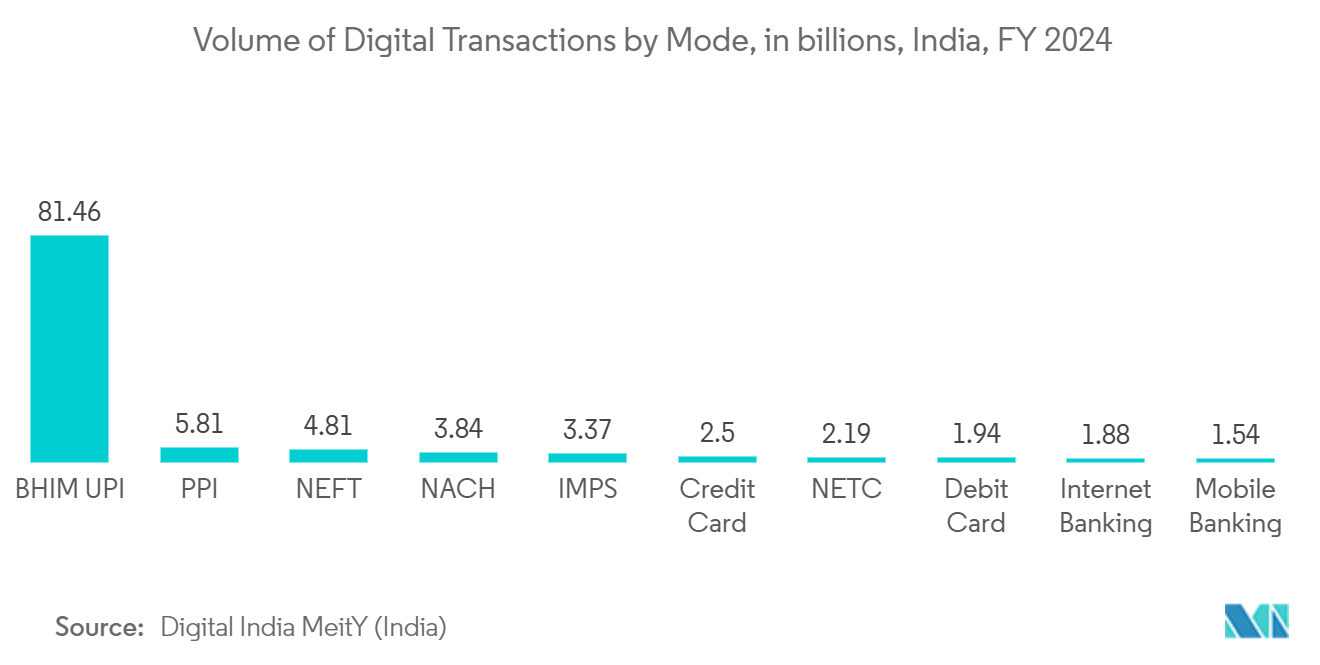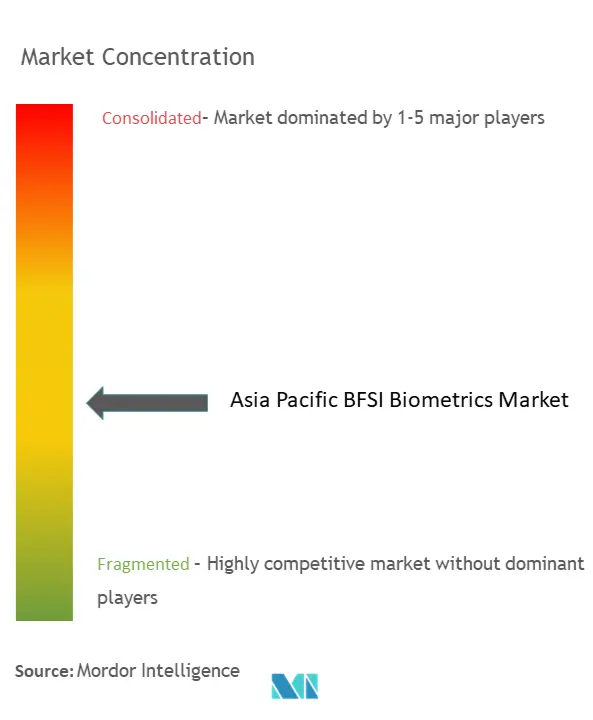Asia-Pacific BFSI Biometrics Market Size and Share

Asia-Pacific BFSI Biometrics Market Analysis by Mordor Intelligence
The Asia-Pacific BFSI Biometrics Market size is estimated at USD 2.47 billion in 2025, and is expected to reach USD 5.53 billion by 2030, at a CAGR of 17.5% during the forecast period (2025-2030).
- Banks and financial institutions use innovative security technologies to improve customer satisfaction that complies with legal guidelines, can be maintained safely at an affordable cost, and can improve performance. To provide banks with a more extensive level of security, integrating biometric technology into an established security system contributes significantly to its effectiveness.
- Biometrics automatically identifies customers using biomorphic characteristics such as iris, voice recognition, and fingerprints. In Asia-Pacific, banks also widely use biometrics in their core banking systems to authenticate customer data. To expand their customer base while preventing fraud, several Asian companies have already announced biometric initiatives, product offers, and awards supporting technology-promoting financial services.
- The rigorous adoption of advanced technologies like artificial intelligence (AI) in the banking sector provides an enormous opportunity to upgrade biometrics solutions for fraud prevention. For instance, OneConnect Financial Solutions uses eKYC to provide reliable and quick-to-market digital banking solutions across Southeast Asia. Centrio and OneCosmo are among the solutions that incorporate eKYC. Centrio is digital banking in a box for mobile, while OneCosmo supports lenders with an easily deployable all-in-one digital banking solution.
- In May 2023, in India, about twenty-two financial establishments were authorized to conduct authentication using the Aadhaar biometric ID by the provisions of the Prevention of Money Laundering Act (PMLA), 2002.
- Several leading players are expanding their services in Asia, which is expected to propel the market's growth in the coming years. For instance, in May 2023, IDEX Biometrics announced the expansion in the Asian market with a partnership with DoelPay, which took advantage of the growing demand for biometric cards in Bangladesh. This strategic partnership addresses the interests and needs of cutting-edge payment solutions by introducing advanced biometric payment cards to the country.
- However, biometrics can pose a threat to data security and privacy concerns. In addition, using biometrics in banking and financial services may infringe on people's domestic privacy. It is also possible to abuse biometric data obtained from the processing of those geometries when accessed with an algorithm that extracts templates from original images. This may be a possible challenge for the growth of the market studied.
- Macroeconomic factors such as government regulations on adopting the biometrics market and additional charges implemented by financial institutions to provide such services continue to influence the market's growth. Geopolitical tensions, such as China's rising geopolitical disputes with other countries, also affect the growth of the market studied in the region, as China is among the major suppliers of biometric hardware solutions in the area.
Asia-Pacific BFSI Biometrics Market Trends and Insights
ATM Application is Expected to Witness a Significant Growth
- Due to heightened security concerns, such as increasing ATM scams, Asia-Pacific became one of the significant markets for biometric technology. This forced the BFSI industry to adopt suitable authentication systems for dynamically inspecting each record and identifying possible threats from humans.
- In emerging Asian countries such as Malaysia, Taiwan, and Thailand, where many banks operate on a proprietary network, the ATM industry is growing exponentially. An increasing customer base in these countries will likely stimulate the demand for ATM services, driving the number of ATMs. For instance, according to the Financial Supervisory Commission (Taiwan), in 2023, more than 121 million ATM cards were circulated in Taiwan.
- According to the Financial Supervisory Commission Taiwan, in 2023, there were over 32,957 automatic service machines of financial institutions in Taiwan. Hence, the growing density of ATMs and services, especially in the country's BFSI sector, requires robust security infrastructure to ensure the safety of consumers, which is driving opportunities in the studied market.
- Government regulations regarding securing client data and the growing rate of ATM thefts are the significant factors driving the BFSI sectors to implement biometric authentication solutions at ATMs.
- Features such as facial recognition and one-time password (OTP) are applied to enhance account security and user privacy. Face recognition technology enables the machine to identify every user uniquely, thus making the face a key. Due to theft and duplicity of ATM cards, the risk of fraud is eliminated. For instance, in June 2023, it was announced by the Japanese Seven Bank that it will enable its customers to bring cash into and out using face recognition at approximately 20,000 ATMs nationwide at the beginning of March 2024.

India is Expected To Witness Significant Growth
- The Indian banking industry is undergoing an accelerated digitization process to gain more value. Banks and other financial institutions continuously face a threat from hackers that can cause damage worth millions of money. This led banks to increase their cyber security, and there is a need for complete cyber security in financial institutions.
- Banks continuously implemented measures and mechanisms to mitigate cyber risks and fraud. Some steps covered include hardware tokens, software tokens, OTPs, and biometrics. To reduce the potential for fraud, banks select multi-factor authentication, and users must submit a biometric identifier. Indian banks are increasingly using biometrics to their fullest potential, with fingerprints, voice patterns, iris scans, and other commonly applied parameters in their authentication.
- The Government of India is committed to expanding the use of digital transactions in the Indian economy, which is expected to increase the quality and strength of the banking industry and ease of life for citizens.
- According to Digital India, as of January 2024, the Bharat Interface for Money (BHIM) Unified Payments Interface (UPI) was the most used mode of digital payments in India, with a transaction volume of around 81 billion transactions. PPI followed with around four billion transactions. In FY 2023, UPI made most transactions across sectors such as online retail, food delivery, mobility, and e-health.
- In March 2023, the governor of the Reserve Bank of India (RBI) announced a mission to be undertaken during the Digital Payments Awareness Week by 'Har Payment Digital' month. This initiative reflects the RBI's objective to enable all Indians to pay by Digital means. Such trends will promote the adoption of biometric technologies in the BFSI industry, creating a favorable ecosystem for market growth.

Competitive Landscape
The Asia-Pacific BFSI biometrics market is moderately competitive. Players involve themselves in R&D, innovations, mergers and acquisitions, partnerships, and collaborations to establish a competitive edge. Some of the major players in the market are NEC Corporation, Veridium, HID Global Corporation, Fujitsu, Innovatrics, etc. Some of the recent developments are,
• March 2024 - Minkasu Inc. (MinkasuPay), a biometric authentication solutions provider, revealed that it obtained a patent in India for its biometric 2-factor Authentication (2FA) technology. This innovative technology was developed and introduced five years ago, demonstrating Minkasu's foresight in anticipating the need for safer alternatives to OTP, as highlighted in the RBI's recent guidance. Minkasu's achievement in securing this patent showcases its commitment to staying ahead of the curve in biometric authentication.
• February 2024 - In a strategic move, IDEX Biometrics and KONA I partnered to launch biometric payment and access cards in Japan. Their collaboration aims to introduce cutting-edge ID and biometric payment card solutions. These advanced smart cards prioritize digital security, boasting robust authentication measures. They are designed to integrate seamlessly with popular protocols like FIDO2, emphasizing both customer satisfaction and security. These customized solutions promise top-tier user experiences.
Asia-Pacific BFSI Biometrics Industry Leaders
-
NEC Corporation
-
Veridium
-
HID Global Corporation
-
Fujitsu
-
Innovatrics
- *Disclaimer: Major Players sorted in no particular order

Recent Industry Developments
- January 2024: Mastercard announced the launch of an authentication service that enables consumers to use fingerprints and facial recognition instead of fraud-prone passwords when logging in or making changes to accounts.
- January 2024: NEXT Biometrics announced its expansion in Asia. The company announced that its FAP20 recently obtained the esteemed China ID certification with the help of a local Chinese partner. China ID is a crucial security standard in the country, much like India's Aadhaar program, allowing NEXT's clients to enter previously inaccessible market sectors. With this development, NEXT is expected to introduce its products to the competitive government and banking industries, showcasing the incorporation of the advanced FAP20 fingerprint sensor for enhanced security.
Asia-Pacific BFSI Biometrics Market Report Scope
The study tracks the revenue accrued through the sale of biometrics in the BFSI sector by various players in Asia-Pacific. The study also tracks the key market parameters, underlying growth influencers, and major vendors operating in the industry, which supports the market estimations and growth rates over the forecast period. The study further analyses the overall impact of COVID-19 aftereffects and other macroeconomic factors on the market. The report’s scope encompasses market sizing and forecasts for the various market segments.
The Asia-Pacific BFSI biometrics market is segmented by authentication type (single authentication factor, multi-factor authentication), by contact type (contact-based, non-contact based), by product type(voice recognition, facial recognition, fingerprint identification, vein recognition, iris recognition), by application (door security, ATM, internet banking, mobile banking, payment authentication), by country(China, Japan, India, South Korea, Rest of Asia-Pacific). The market sizes and forecasts are provided in terms of value (USD) for all the above segments.
| Single Authentication Factor |
| Multi-Factor Authentication |
| Contact-based |
| Non-contact Based |
| Voice Recognition |
| Facial Recognition |
| Fingerprint Identification |
| Vein Recognition |
| Iris Recognition |
| Door Security |
| ATM |
| Internet Banking |
| Mobile Banking |
| Payment Authentication |
| China |
| Japan |
| India |
| South Korea |
| Australia |
| Singapore |
| Thailand |
| By Authentication Type | Single Authentication Factor |
| Multi-Factor Authentication | |
| By Contact Type | Contact-based |
| Non-contact Based | |
| By Product Type | Voice Recognition |
| Facial Recognition | |
| Fingerprint Identification | |
| Vein Recognition | |
| Iris Recognition | |
| By Application | Door Security |
| ATM | |
| Internet Banking | |
| Mobile Banking | |
| Payment Authentication | |
| By Country*** | China |
| Japan | |
| India | |
| South Korea | |
| Australia | |
| Singapore | |
| Thailand |
Key Questions Answered in the Report
How big is the Asia-Pacific BFSI Biometrics Market?
The Asia-Pacific BFSI Biometrics Market size is expected to reach USD 2.47 billion in 2025 and grow at a CAGR of 17.5% to reach USD 5.53 billion by 2030.
What is the current Asia-Pacific BFSI Biometrics Market size?
In 2025, the Asia-Pacific BFSI Biometrics Market size is expected to reach USD 2.47 billion.
Who are the key players in Asia-Pacific BFSI Biometrics Market?
NEC Corporation, Veridium, HID Global Corporation, Fujitsu and Innovatrics are the major companies operating in the Asia-Pacific BFSI Biometrics Market.
What years does this Asia-Pacific BFSI Biometrics Market cover, and what was the market size in 2024?
In 2024, the Asia-Pacific BFSI Biometrics Market size was estimated at USD 2.04 billion. The report covers the Asia-Pacific BFSI Biometrics Market historical market size for years: 2019, 2020, 2021, 2022, 2023 and 2024. The report also forecasts the Asia-Pacific BFSI Biometrics Market size for years: 2025, 2026, 2027, 2028, 2029 and 2030.
Page last updated on:
Asia-Pacific BFSI Biometrics Market Report
Statistics for the 2025 Asia-Pacific BFSI Biometrics market share, size and revenue growth rate, created by Mordor Intelligence™ Industry Reports. Asia-Pacific BFSI Biometrics analysis includes a market forecast outlook for 2025 to 2030 and historical overview. Get a sample of this industry analysis as a free report PDF download.



